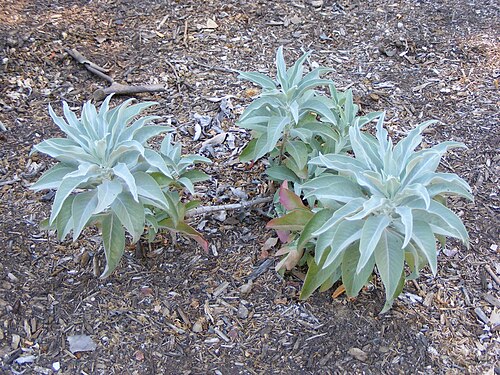White sage
| Habit | shrub
| |
|---|---|---|
| Height: | ⇕ | 4 ft"ft" can not be assigned to a declared number type with value 4. |
| Width: | ⇔ | 3 ft"ft" can not be assigned to a declared number type with value 3. |
| Lifespan: | ⌛ | perennial |
| Bloom: | ❀ | early spring, mid spring, late spring |
| Exposure: | ☼ | sun |
|---|---|---|
| Features: | ✓ | flowers |
| USDA Zones: | 9 to 11 | |
| Flower features: | ❀ | blue, purple, white |
|
Salvia > |
apiana > |
Salvia apiana, also known as white sage, bee sage, or sacred sage, is an evergreen perennial shrub of the genus Salvia, the sages. It is native to the southwestern United States and northwestern Mexico, being found mainly in the coastal sage scrub habitat of Southern California and Baja California, on the western edges of the Mojave and Sonoran deserts.
White sage is a sub-shrub that can grow over 1 meter tall. The leaves (about 4–8 cm long) are generally basal and are covered with dense hairs, which give them a white coloring. The leaves are widely lanceolate with tapered bases, and the margins are minutely toothed. The inflorescence is a spike-like cluster with few flowers. The white flowers have lavender spots and streaks. The flowers have a bilateral shape and are about 12–22 mm in length. Both the stamens and styles are exserted past the end of the flower lobes. The 2.5– to 3-millimeter-long fruit is a shiny, light-brown nutlet.
White sage is a common plant that requires well-drained dry soil, full sun, and little water. The plant occurs on dry slopes in coastal sage scrub, chaparral, and yellow-pine forests of Southern California to Baja California at less than 1500 m elevation.
Cultivation
Propagation
Pests and diseases
Varieties
Gallery
References
- Standard Cyclopedia of Horticulture, by L. H. Bailey, MacMillan Co., 1963
External links
- w:White sage. Some of the material on this page may be from Wikipedia, under the Creative Commons license.
- White sage QR Code (Size 50, 100, 200, 500)



